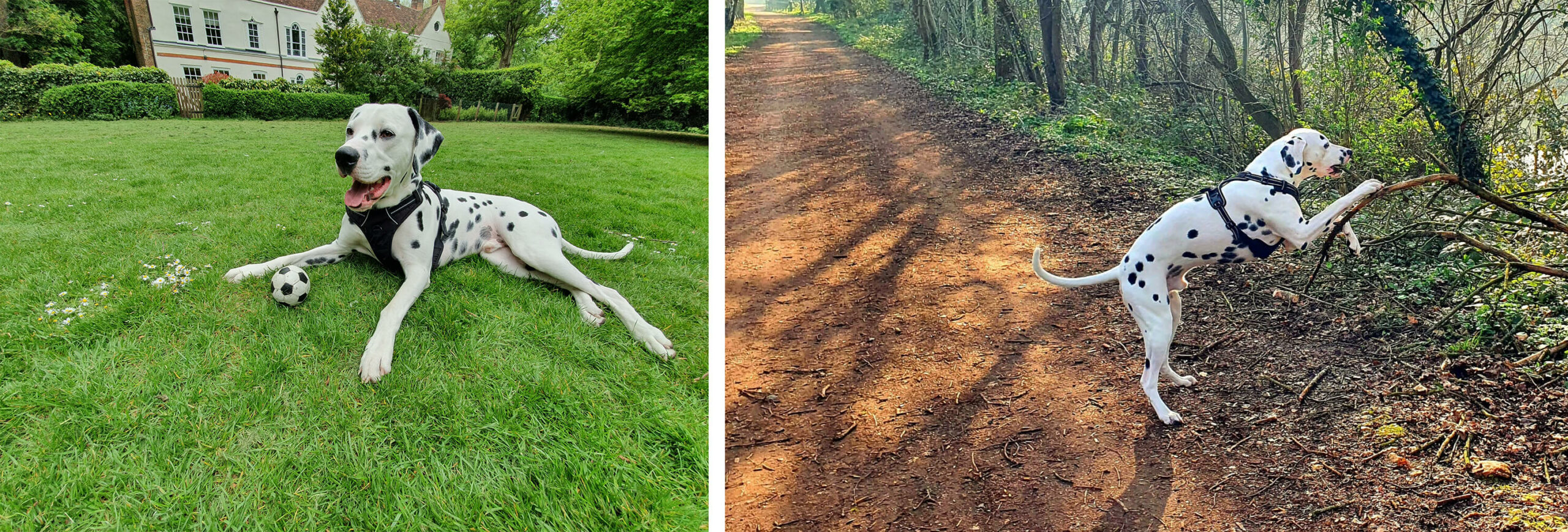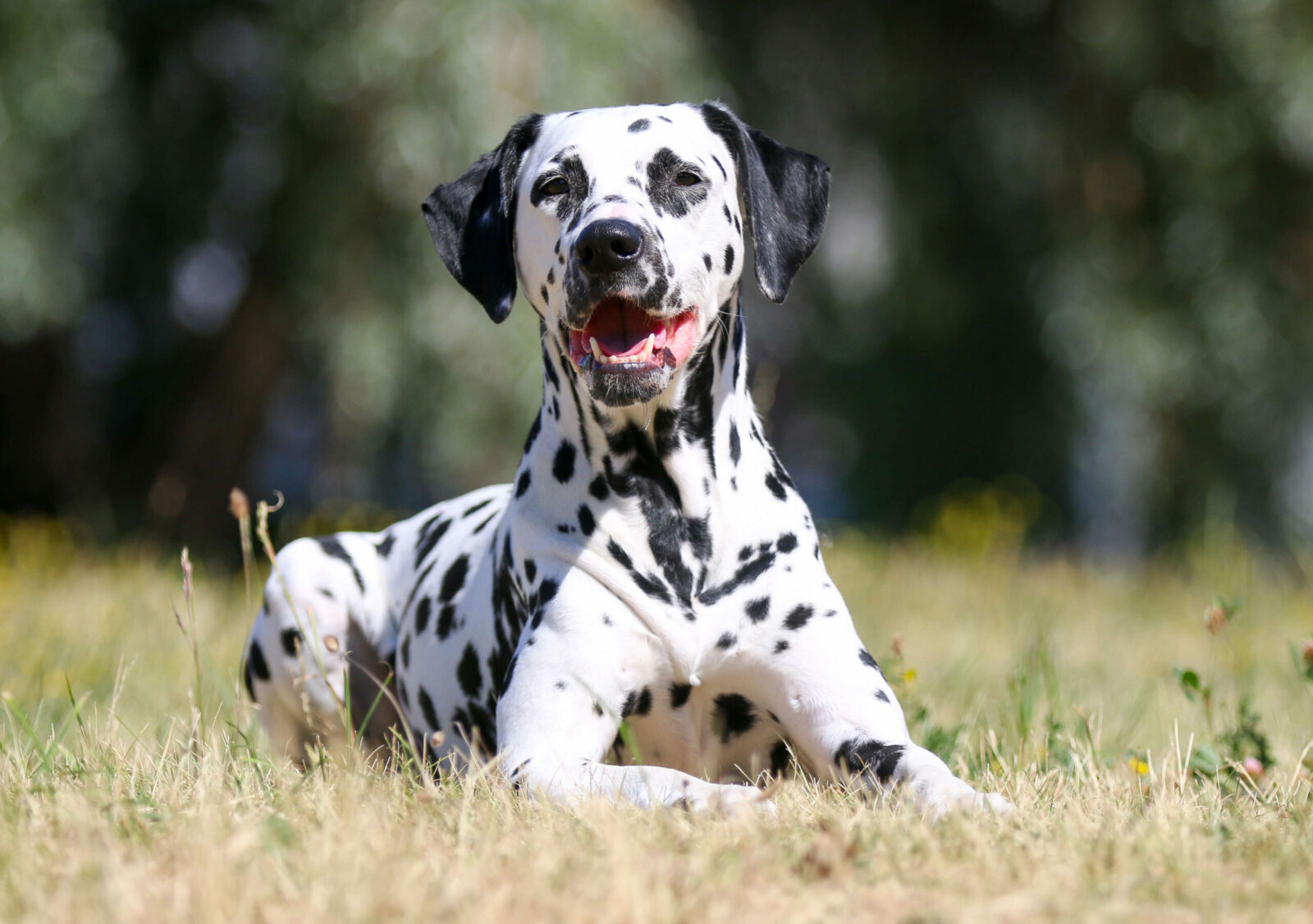Blog, Urinary Stones
Diet for dogs with urate stones
Updated August 2024 by Kristina Johansen
The diet of a stone-forming dog is the most important factor in preventing future stones. In this guide to uroliths, our primary focus will be on diet for dogs with urate stone, also known as uric acid stones. However, we will also delve into various relevant topics such as:
- The biochemistry behind urate stones.
- Genetic predisposition
- Signs & symptoms
- Prevention & monitoring
So, without further ado, let’s dive into everything you need to know about protecting your dog from urate stones through the right diet.
Which dogs are susceptible?
Generally speaking, there are two types of dogs that are prone to developing urate stones: those with liver shunts and those with a genetic predisposition.
A liver shunt is a condition where blood flow to and through the liver is compromised. This prevents the proper processing of the by-products of digestion and other wastes. It also prevents the absorption of nutrients that the liver would normally process.
A genetic predisposition means that, under the right conditions, a dog breed is more likely to develop a disease. Dalmatian dogs have a predisposition to urate stones due to a metabolic defect inherent in this breed, causing high amounts or uric acid in the urine. Urate stones are also much more common in male Dalmatians than female dogs.
Uric acid stones and Dalmatians
Uric acid stones are formed from foods that contain molecules called purines. These substances are found in high concentrations in common protein. Some proteins contain more purines than others. For example, organ meats have the highest levels of purines, whereas vegetable and dairy based proteins have the lowest.
In most dogs, the purines from food are broken down into uric acids in the liver. This is then converted into a water-soluble substance, called allantoin. The allantoin then passes from the kidneys to the bladder to be excreted in urine.
I’m a visual person, so I made a little diagram.

The Dalmatian is unique among dogs since the last step doesn’t take place. The purines are broken down into uric acid, but the liver isn’t able to convert it into allantoin. This means that Dalmatians must excrete uric acid in their urine without the last conversion.

Because uric acid isn’t water soluble, it can crystallise. Consequently, these uric acid crystals accumulate in the kidneys and move to the bladder where lots of these crystals can come together to form a stone. Urate stones can be a medical emergency for your dog because they can grow large enough to block the flow of urine completely. If your dog is unable to pass urine, it is a life-threatening situation.
In case you are curious, this is an example of how urate stones would look like when removed.
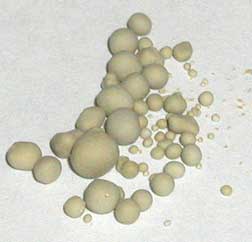
Stones: the signs and symptoms
Urate crystals can be very irritating to a dog’s kidneys and bladder and can trigger urinary tract infections. Symptoms of possible uric acid crystals or stones and signs to look out for include:
- Straining and/or discomfort during urination
- Blood in the urine
- Cloudy urine
- Seeing gritty material in the dog’s urine
- Passing only small amounts of urine
- Abnormal urine streams
- Urine leakage accidents around your home
Hopefully, this is an issue that will never happen but if your dog is a Dalmatian or mix, and you suspect crystals or stones, it’s important to ask your veterinarian to collect a urine sample immediately to check for signs of a problem.
How are urate stones diagnosed?
In some cases, your vet may be able to feel urate stones in the bladder. However, some stones are too small to be felt this way and unfortunately, urate bladder stones are often radiolucent, meaning that they are not always visible on X-rays. This means that your vet will need to perform other imaging studies, such as a bladder ultrasound or a contrast radiographic study, a specialised technique that uses dye to outline the stones in the bladder, in order to see the stones.
How will my vet treat uric acid stones?
Urate stones cannot be left untreated. There are two main reasons for this:
- The presence of stones in the bladder can damage its inner layer and create pain, inflammation and predispose your dog to bacterial infections.
- If the stones are too large, they risk blocking the urethra. If a blockage prevents your dog from urinating, this is an emergency and surgery must be performed immediately.
Urate stones can also be dissolved with a combination of a very restricted purine diet, urine alkalization, and control of any secondary bladder infections. On average, this approach takes about 3 – 4 months for stones to dissolve.
More recent techniques use high ultrasonic waves to break the stones into small fragments, which can then be flushed out of the bladder.
Your vet will discuss the pros and cons of each of these options with you and help you decide which option is best for your dog.
How can I prevent and monitor my dog for the recurrence of urate stones?
Once a dog has had urate stones that have been cleared, the focus turns to prevention and monitoring.
Work with your veterinarian to develop a regular plan for urine testing and either X-rays or ultrasound examination to monitor for the recurrence of stones. This way, you can identify new stones while they are still small enough to be treated without surgery.
Nutrition plays a vital role in both managing and preventing the development of urate stones in dogs.
Diet for dogs with uric acid stones
The key part of the prevention plan is diet. I have been working with Dalmatians for over 13 years now and never had an issue with stone formation or recurrence once the right diet is being fed. The trouble is that some owners don’t want to accept what the right diet is because it’s a vegetarian diet.
Wait. What? …I hear you ask. Okay, let me explain.
To reduce the likelihood of urate stone formation our primary goal is to reduce your dog’s intake of purines. Without the purines that trigger urate stone formation, even dogs with a genetic predisposition can lead normal lives.
Foods that are high in purines include:
- Seafood,
- poultry,
- red meats,
- and particularly organ meat such as kidneys and liver
The floods listed below are considered virtually purine-free:
- Dairy products,
- tofu,
- eggs,
- most vegetables,
- and fruits.
For this reason, a low purine diet typically focuses on vegetarian ingredients.
In case you’re still skeptical, here’s the results from a dog I worked with before and after transitioning to a vegetarian diet.
Before diet change:
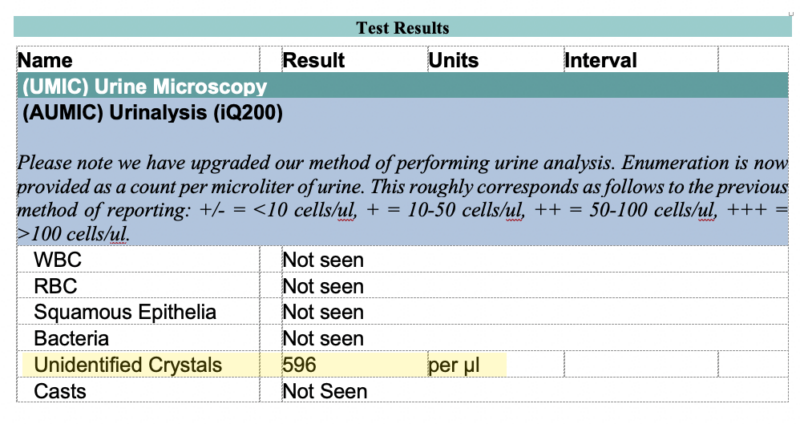
After diet change:
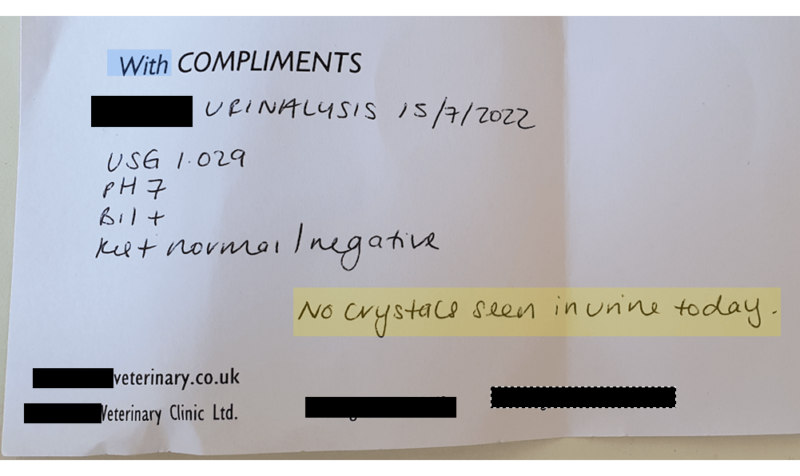
There are a few veterinary prescription diets formulated to reduce the likelihood of urate stones, but you can also prepare your dog’s food at home using the same high-quality ingredients that you eat.
There are several health benefits of making your dog’s food at home. Because most high protein foods are also high in purines, commercial diets are often low in protein. However, it is not the quantity of protein that causes urate problems, it’s the type of protein. By feeding a homemade diet you can easily choose and prepare food ingredients that are high in protein and low in low purines such as eggs, cheese and yogurt.
By feeding your dog a home-prepared diet rather than a dry kibble diet, you also increase the amount of water they are drinking. And as mentioned above, increased water consumption makes urine more dilute and can help prevent stones forming.
Keeping your dog well hydrated is also vital. This dilutes their urine, which in turn dilutes the levels of chemicals that promote stone formation, and so decreases the chance of your dog developing bladder stones.
You can help your dog drink more water by placing a few bowls of fresh water in different locations around the house. Always make sure the water is fresh and that you change it regularly. In the ideal world we are aiming to maintain urine specific gravity <1.020.
Some Dalmatian owners believe that giving their dogs who are prone to forming urate stone only mineral-free distilled water has helped prevent more stones from forming. No scientific evidence for this exists.
Never add vitamin C to the diet of a stone forming dog, as it’s likely to acidify the urine. Brewer’s yeast is another popular supplement that should be avoided due to its very high purine content.
Take away for Dalmatian owners
Uric acid stones can be very painful. But the good news is that sticking to specific dietary recommendations and monitoring your dog’s urine can reduce the chances of them developing or coming back in dogs who have previously had them.
Make sure your dog always has access to plenty of fresh water. Keeping them hydrated keeps the urine from becoming concentrated and makes crystals less likely to form
If you’d like to try cooking for your dog, it is vital you get your recipe from a qualified dog nutritionist to ensure that the diet is meeting all your dog’s nutritional needs, in particulate to ensure that the diet meets the body’s requirements of amino acids.
Say hello to Happy!
His owner knew the importance of immediate diet changes when large quantities of crystals were found in his urine. She got in contact and Happy was put on a vegetarian homemade diet. One month on, his urinalysis came back clean! This beautiful puppy is very lucky to have an owner who acted quickly on his behalf and I was very lucky to get to work with both of them.
